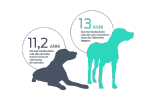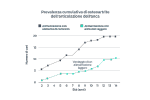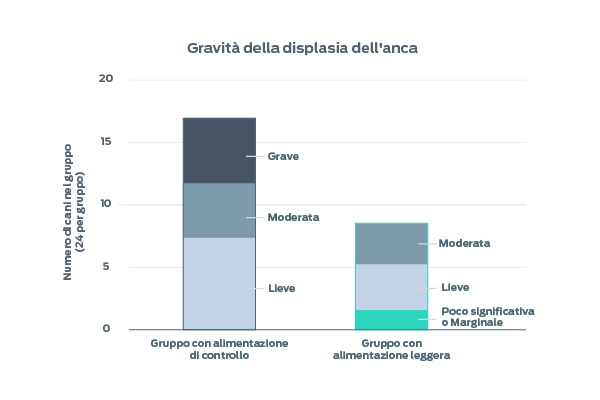

Per decenni, gli scienziati hanno studiato come la restrizione alimentare, senza malnutrizione, possa contribuire ad aumentare la speranza di vita e ritardare l'insorgenza di varie patologie correlate all'età in alcuni mammiferi.1-3
La ricerca di Purina ha dimostrato che il mantenimento di condizioni corporee ottimali fin da cuccioli e durante tutta la vita può migliorare sia la speranza di vita che gli indicatori dello stato di salute generale dei cani.3-5
La ricerca di Purina


Grafico adattato da Kealy et al., 2002
In questo studio di rilievo, i ricercatori hanno monitorato lo stato di salute di 48 Labrador Retriever nell’arco di tutta la loro vita, durante la quale metà dei cani veniva nutrita il 25% in meno (alimentazione leggera) rispetto all’altro gruppo, che riceveva un’alimentazione di controllo. I risultati hanno mostrato che i cani alimentati mantenendo una condizione corporea magra dalla fin da cuccioli hanno vissuto meglio e più a lungo.
- La durata media della vita è stata prolungata di 1,8 anni, pari al 15%. La durata media della vita dei cani alimentati in modo leggero è stata di 13 anni rispetto agli 11,2 anni dei cani del gruppo di controllo.
- In questi cani, la restrizione alimentare del 25% ha inoltre ritardato l'insorgenza di segni di malattie croniche. 4
- La restrizione alimentare non ha avuto effetti negativi sullo sviluppo scheletrico, sulla struttura o sul metabolismo. 4
I cuccioli nutriti con una razione giornaliera leggera mostrano articolazioni dell’anca più sane

A 2 anni di età, la frequenza della displasia dell'anca nei cani alimentati in modo leggero era del 50% inferiore a quella del gruppo di controllo, ed era molto meno grave.
Il grafico mostra come la percentuale dei cani di 12 anni, nutriti con alimento leggero ed affetti da osteoartrite, era quasi la stessa di quella dei cani nutriti con l’alimento di controllo con la metà degli anni.
Alla fine dello studio, l'83% dei cani nutriti con l’alimento di controllo aveva sviluppato segni radiografici di osteoartrite dell'anca rispetto al 50% di quelli nutriti con l’alimento leggero.5

Anche la prevalenza e la gravità delle osteoartriti della spalla e del gomito erano inferiori nei cani nutriti con alimentazione leggera. A 8 anni di età, la prevalenza di osteoartriti a due o più articolazioni era del 77% tra i cani del gruppo di controllo, ma solo del 10% tra i cani nutriti con alimentazione leggera.6

I cani snelli hanno inoltre avuto altri vantaggi per la salute:
- Mostravano una maggiore sensibilità all'insulina, il che comporta una migliore regolazione del glucosio
- Sono stati in grado di mantenere nel tempo un’adeguata risposta del sistema immunitario
- Il declino correlato all'età si è verificato più avanti nella vita4
Aspetti chiave da ricordare
- Uno studio sulla durata della vita condotto per 14 anni su Labrador Retriever ha dimostrato che, se nutriti per mantenere una condizione di peso corporeo ottimale fin da cuccioli e per tutta la vita, i cani vivono meglio e più a lungo.
- La speranza media di vita dei Labrador Retriever nutriti con alimento leggero è stata estesa in media di 1,8 anni (15%).
- Il mantenimento di una condizione corporea ottimale per tutta la vita può ritardare l'insorgenza e ridurre la gravità dell'osteoartrite nei cani.
- I cani snelli hanno inoltre mostrato un ritardo nell’insorgenza di altre malattie croniche e correlate all'età.
Scopri come l'alimentazione può aiutare gli animali domestici a vivere una vita migliore e più lunga:
Ulteriori informazioni
1. Fontana, L., Partridge, L., & Longo, V. D. (2010). Extending healthy life span--from yeast to humans. Science (New York, N.Y.), 328(5976), 321–326.
2. Kaeberlein, M., Creevy, K. E., & Promislow, D. E. (2016). The dog aging project: translational geroscience in companion animals. Mammalian genome: official journal of the International Mammalian Genome Society, 27(7-8), 279–288.
3. Kealy, R.D., Lawler, D.F., Ballam, J.M., Mantz, S.L., Biery, D.N., Greeley. E.H., & Stowe, H.D. (2002). Effects of diet restriction on life span and age-related changes in dogs. Journal of the American Veterinary Medical Association, 220, 1315-1320.
4. Lawler, D.F., Larson, B.T., Ballam, J.M., Smith, G.K., Biery, D.N., Evans, R.H., & Kealy, R.D. (2008). Diet restriction and ageing in the dog: major observations over two decades. British Journal of Nutrition, 99(4), 793-805.
6. Kealy, R.D., Lawler, D.F., Ballam, J.M., Lust, G., Biery, D.N., Smith, G.K., & Mantz, S.L. (2000). Evaluation of the effect of limited food consumption on radiographic evidence of osteoarthritis in dogs. Journal of the American Veterinary Medical Association, 217(11), 1678-1680.
Altri lavori di ricerca attinenti a questo studio durato 14 anni:
6.1. Huck, J. L., Biery, D. N., Lawler, D.F., Gregor, T. P., Runge, J. J., Evans, R.H., Kealy, R.D., & Smith, G. K. (2009). A longitudinal study of the influence of lifetime food restriction on development of osteoarthritis in the canine elbow. Veterinary Surgery, 38(2), 192- 198.
6.2. Greeley, E. H., Kealy, R.D., Ballam, J. M., Lawler, D. F., & Segre, M. (1996). The influence of age on the canine immune system. Veterinary Immunology and Immunopathology, 55(1-3), 1-10.
6.3. Greeley, E.H., Ballam, J.M., Harrison, J.M., Kealy, R.D., Lawler, D.F., & Segre, M. (2001). The influence of age and gender on the immune system: a longitudinal study in Labrador Retriever dogs. Veterinary Immunology and Immunopathology, 82(1-2), 57-71.
6.4. Greeley, E.H., Spitznagel, E., Lawler, D.F., Kealy, R.D., & Segre, M. (2006). Modulation of canine immunosenescence by life-long caloric restriction. Veterinary Immunology and Immunopathology, 111(3-4), 287-299.
6.5. Kealy, R.D., Olsson, S.E., Monti, K.L., Lawler, D.F., Biery, D.N., Helms, R.W., Lust, G., & Smith, G.K. (1992). Effects of limited food consumption on the incidence of hip dysplasia in growing dogs. Journal of the American Veterinary Medical Association, 201(6), 857-863.
6.6. Kealy, R.D., Lawler, D.F., Ballam, J.M., Lust, G., Smith, G.K., Biery, D.N., & Olsson, S.E. (1997). Five-year longitudinal study on limited food consumption and development of osteoarthritis in coxofemoral joints of dogs. Journal of the American Veterinary Medical Association, 210(2), 222-225.
6.7. Larson, B. T., Lawler, D.F., Spitznagel, E. L., & Kealy, R.D. (2003). Improved glucose tolerance with lifetime diet restriction favorably affects disease and survival in dogs. Journal of Nutrition, 133(9), 2887-2892.
6.8. Lawler, D.F., Evans, R. H., Larson, B.T., Spitznagel, E. L., Ellersieck, M. R., & Kealy, R. D. (2005). Influence of lifetime food restriction on causes, time, and predictors of death in dogs. Journal of the American Veterinary Medical Association, 226(2), 225-231.
6.9. Lawler, D. F., Ballam, J. M., Meadows, R., Larson, B. T., Li, Q., Stowe, H. D., & Kealy, R. D. (2007). Influence of lifetime food restriction on physiological variables in Labrador retriever dogs. Experimental Gerontology, 42(3), 204-214.
6.10. Lawler, D. F., Larson, B. T., Ballam, J. M., Smith, G. K., Biery, D. N., Evans, R. H., & Kealy, R. D. (2007). Diet restriction and ageing in the dog: major observations over two decades. British Journal of Nutrition, 99(4), 793-805.
6.11. Richards, S. E., Wang, Y., Lawler, D., Kochhar, S., Holmes, E., Lindon, J. C., & Nicholson, J. K. (2008). Self-modeling curve resolution recovery of temporal metabolite signal modulation in NMR spectroscopic data sets: application to a life-long caloric restriction study in dogs. Analytic Chemistry Journal, 80(13), 4876-4885.
6.12. Richards, S. E., Wang, Y., Claus, S. P., Lawler, D., Kochhar, S., Holmes, E., & Nicholson, J. K. (2013). Metabolic phenotype modulation by caloric restriction in a lifelong dog study. Journal of Proteome Research, 12(7), 3117-3127.
6.13. Runge, J. J., Biery, D. N., Lawler, D. F., Gregor, T. P., Evans, R. H., Kealy, R. D., Szabo, S. D., & Smith, G. K. (2008). The effects of lifetime food restriction on the development of osteoarthritis in the canine shoulder. Veterinary Surgery, 37(1), 102-107.
6.14. Smith, G. K., Lawler, D. F., Biery, D. N., Powers, M. Y., Shofer, F., Gregor, T. P., & Kealy, R. D. (2012). Chronology of hip dysplasia development in a cohort of 48 Labrador retrievers followed for life. Veterinary Surgery, 41(1), 20-33.
6.15. Stowe, H. D., Lawler, D. F., & Kealy, R. D. (2006). Antioxidant status of pair-fed Labrador retrievers is affected by diet restriction and aging. Journal of Nutrition, 136(7), 1844-1848.
6.16. Szabo, S. D., Biery, D. N., Lawler, D. F., Shofer, F. S., Powers, M. Y., Kealy, R. D., & Smith, G. K. (2007). Evaluation of a circumferential femoral head osteophyte as an early indicator of osteoarthritis characteristic of canine hip dysplasia in dogs. Journal of the American Veterinary Medical Association, 231(6), 889-92.
6.17. Wang, Y., Lawler, D., Larson, B., Ramadan, Z., Kochhar, S., Holmes, E., & Nicholson, J. K. (2007). Metabonomic investigations of aging and caloric restriction in a life-long dog study. Journal of Proteome Research, 6(5), 1846-1854.


